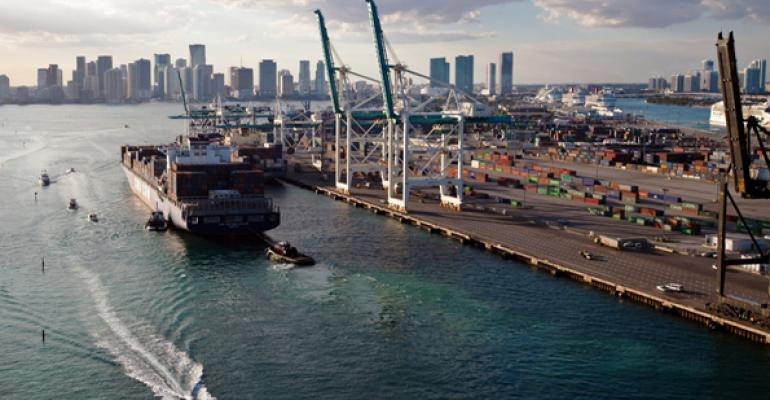Miami’s industrial market, currently enjoying record low vacancy of about 4.5 percent, is attracting more powerful investors who want to buy in as demand overwhelms supply and new Panamax-sized ships pull up to the newly expanded port.
Florida has one of the most dynamic industrial markets in the country, being the only state almost completely surrounded by the ocean, but known primarily for its main airport, not its ports. Miami International is ranked number for international freight, moving 1.8 million tons annually, and the city’s industrial market is organized mostly around flight shipping. Miami’s airport specializes in perishable cargos, such as fruit and flowers from South America.
Now, Miami’s industrial market is seeing strong demand from foreign and domestic investors, according to industry experts. Private investors are searching for stable, multi-bay properties offering returns in the mid-6 to mid-7 percent range, according to a recent report from brokerage firm Marcus & Millichap. At the same time, developers are motivated to begin speculative construction projects by tight leasing conditions and expanding tenants.
For example, Nick Wigoda, senior vice president in the Miami office of commercial real estate services firm JLL, says many new institutional buyers and national tenants have been pushing into the region. San Francisco-based REIT Terreno Realty Corp., for example, added to its Miami portfolio in February with the $8.9 million purchase of a two-building, 85,000-sq.-ft. property in Medley that is 100 percent leased.
“Land is really getting pushed up in price, there’s just a scarcity of well-located land to build [on],” Wigoda says. “There’s about one million square feet of new construction right now, most of it being built on speculation, and it’s already up to 40 percent leased.”
The Miami International Airport is still the largest draw for industrial demand, though the region may get more activity once Port Miami finishes its $205 million dredging project this year in order to accommodate the post-Panamax ships. A more direct route for truck traffic from the port, the $663 million Port Tunnel Project, was finished last year. However, because many shippers can reach more population centers by pulling into mid-East-Coast ports, it’s not clear how the Panama Canal expansion will impact Florida, Wigoda notes.
“They’ve done an excellent job to get the port ready for the bigger ships and cranes, and the tunnel ready,” he says. “But nobody knows for sure what the net effect will be. Right now, there [are] almost one million TEUs that go through Miami ports each year. How much it goes up is yet to be determined. However, it’s clear the fundamentals are getting better as things are expanding, so that alone justifies all the institutional interest.”
Rents for industrial properties ended the year up 6 percent from year-end 2013, with an average asking rate of $6.50 per sq. ft. triple net. The current average is up 28 percent from three years ago, according to a fourth quarter report from commercial real estate services firm NGKF. Developers are scrambling to build properties larger than 100,000 sq. ft., with that building size expected to dominate the 1.8 million sq. ft. of upcoming construction in 2015.
However, improvement in rents is more obvious among the smaller properties, than in those over 100,000 sq. ft, says Viola Sanchez, vice president with PS Business Parks Inc., which specializing in developing and managing flex, office and industrial space. Her firm owns the International Commerce Center, the largest industrial property in the region. She says new property supply is sparse because of land constraints, cost of land and area-specific restrictions.
“We are seeing rising prices in smaller industrial space due to high demand from small businesses and limited availability of space,” she says. “Larger businesses have more buying power and/or leverage in the market due to Miami’s many buildings, including the new industrial properties, which are equipped to cater to larger operations.”

